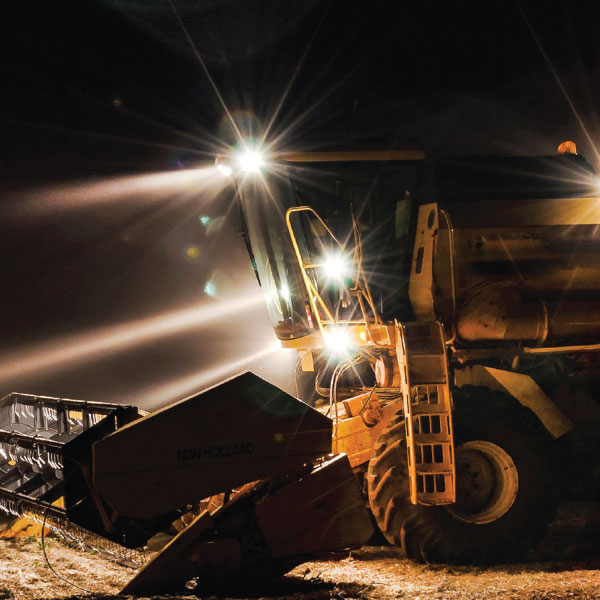Farming work can’t stop because the sun goes down. To get everything done, many farmers have to work well into the night. Whether it’s planting in the spring or harvesting in autumn, darkness can’t be end the workday. While there has always been lighting for tractors and utility vehicles, many of the options have had serious shortcomings. Fortunately, new LED technology has vastly improved lighting for tractors, industrial machinery, UTVs, ATVs and off-road vehicles. LED lights have been documented to illuminate up to 330 percent better than halogen. That intense light is almost like turning night into day, keeping you working the fields longer with better vision of what is ahead of you.
A Lesson on Lights
The unit of measurement used for lights is called a lumen. The greater number of lumens, the more light that is being cast from a source. You’ll sometimes hear lumens referred to as raw lumens, the theoretical output of light, or effective lumens, the actual output of light.
An Overview of Lighting Options
If you’re shopping for tractor lights, here are your most common choices:
Halogen: The standard light used on most tractors today is halogen, which are incandescent lamps consisting of a tungsten filament sealed into a compact transparent housing that is filled with inert gas. You can expect to produce 1,000 lumens at 55 watts and get anywhere from 1,000 to 2,500 hours of service life from halogen lights.
High-Intensity Discharge (HID): A second choice is HID lamos, which have an electrical gas discharge produced by an electric arc. They produce more lumens per watt than a halogen lamp, and last significantly longer with a lifespan anywhere from 6,000 to 20,000 hours. However, HID lights have two distinct disadvantages. First, they require a warm-up period to reach full brightness. Second, they often dim as they age. In fact, HID lighting can deteriorate up to 70% over 10,000 burning hours. They are also sensitive to extreme temperatures.
Light-Emitting Diode (LED): The new technological winner in lighting is LED. These lamps are semi-conductor diodes that emit light when voltage is applied to it. They produce significantly more lumens than halogen and HID. As an example, a 55-watt halogen produces about 1,000 lumens and a 35-watt HID produces 2,500 lumens while a 50-watt LED produces 6,900 lumens. LEDs are also longer lasting than both halogen and HID lamps at 30,000 to 50,000 hours, and LEDs will maintain original brightness throughout their lifespan. More intense brightness allows tractor operators to see farther ahead when on the road, field or trail.
| Type of Light | Lumens | Lifespan | Will dim as they age | Requires warm-up period |
|---|---|---|---|---|
| Halogen | 1,000 at 55 watts | 1,000 to 2,500 hours | Maybe | No |
| HID | 2,500 at 35 watts | 6,000 to 20,000 hours | Yes | Yes |
| LED | 3,600 at 40 watts | 30,000 to 50,0000 hours | No | No |
Not all LEDs are Created Equal
When you look at the pros and cons of lighting options, LEDs offer genuine advantages. However, one issue with LED lights is the potential for radio frequency interference. To combat this issue, you want to make sure you purchase LED lights with interference filters to prevent static on radios. Cheaper quality LEDs are often sold without these filters. Tiger Lights is a respected brand that comes with the filters.
Additional enhancements recommended for LED lights include quality diodes made by a respected manufacturer like CREE, Osram or Phillips, extra silicone to protect against vibration and large aluminum heatsinks for heat dissipation. These features will extend the service life of LED lights.
Versatile Light Patterns
LED lights offer more versatility than halogen and HID when It comes to the light pattern, too. Halogen and HID can only serve as a spotlight with a narrow beam or as a floodlight with a wider beam. It’s possible to place diodes and reflectors in the lamps that produce both a spotlight and floodlight pattern. You will find some LED lamps listed as combo light patterns for this reason, while that option is not possible for halogen and HID lights.
Advantages of LED Lights
LED lights are clearly superior in terms of brightness, service life and overall performance. Upgrading to LED is a wise choice when replacing lighting on tractors, industrial equipment and off-road vehicles. LEDs will enhance safety by giving drivers a better range of vision at night. That alone makes LEDs a preferable choice when replacing lights.

